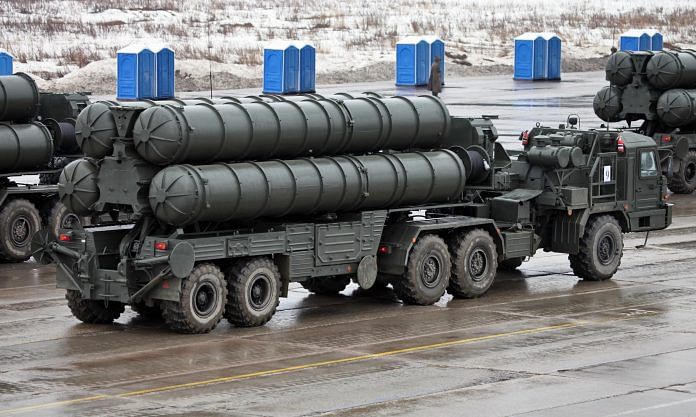US recommends waiver for India under CAATSA, which, many say, was aimed against New Delhi’s bid to buy S-400 air defence missile systems from Russia.
New Delhi: Shortly before she walked into this contentious monsoon session of Parliament, defence minister Nirmala Sitharaman spoke eight feisty words: “It is a US law, not UN law.”
Eight working days later, the import of the words has become clear: The US Tuesday announced that India, along with Indonesia and Vietnam, will likely be exempt from sanctions under Section 231 of its National Defence Authorisation Act, 2019.
New Delhi has, in some ways, used a carrot-and-stick policy to convince the Pentagon of its case for a waiver under the Countering America’s Adversaries Through Sanctions Act (CAATSA).
The CAATSA is aimed chiefly against Russia and Iran. It ensures that Washington D.C. imposes embargoes on the export of military equipment and energy sources by the two countries.
Implications for India
Iran has emerged as India’s second largest supplier of oil. Russia, for decades, has been India’s largest supplier of guns, missiles, fighter jets, aircraft carrier, and even the chief partner for its strategic nuclear submarine programme.
Many believed that CAATSA was aimed against India’s conclusion of an estimated $4.5 billion deal to buy five S-400 Triumf air defence missile systems from Russia. But there was (and is) a lot more at stake if it were to be implemented. Apart from the S-400s, India and Russia are in talks to procure more helicopters — the workhorse Mi-17V5 and the light utility Kamov-226T.
CAATSA covers 39 Russian defence entities, most of which India has dealt with at some point or the other, and still continues to contract for spares and new weapons. Some of these, like the Admiralty Shipyards, are making the Talwar-plus frigates, and are servicing submarines for the Indian Navy. All of these are frontline military equipment for India, despite an increasing share of the US (and Israel) in the country’s arsenal.
The stick
The possibility that its tight military supply situation could be snapping drove the Indian establishment to lobby hard with the US to grant the waiver. Sitharaman herself told a visiting US Congressional delegation earlier this year in New Delhi what she told the media three days before Parliament convened — that India was not bound by US law.
She repeated the same in talks with US Secretary for Defense James Mattis, whom she is scheduled to meet along with foreign minister Sushma Swaraj in September for the first ‘2+2’ talks. Mattis himself took the case to the House and Senate Committee on Armed Service that recommended the waiver Tuesday.
This comes a month after the US renamed its largest military establishment the ‘Indo-Pacific Command’. Admiral Harry Harris was also in New Delhi in May, when he insisted that military supplies and ventures with India would be increased.
That, as per a member of the House and Senate Committee on Armed Service, was the ‘stick’ in the Indian policy. He said that if sanctions were to be imposed in a manner that would hurt India, New Delhi would be driven even deeper into Moscow’s arms, because it was so heavily dependent on what began as a Cold War-era need for supplies.
Even today, despite record sales in the last five years, the combined sales of US and Israeli military equipment is 26 per cent of the Indian arsenal. Russia’s share is more than 62 per cent, even after a decline. This is not accounting for supplies for legacy equipment.
The carrot
The ‘carrot’ in New Delhi’s policy against CAATSA lies in the current contracts it has with the US, and in promised future orders (that would generate revenues and jobs for America). India has done this in the past with both Russia and the US.
Between 2000 and 2002, India leveraged buying power and ordered four Il-78s (to be modified by the Israelis as Phalcon AWACS) that allowed Russian politicians to keep the Ilyushin plant going.
For the US, the Indian order for ten C-17 Globemaster III heavylifters allowed Boeing to keep its assembly line running.
India has now contracted the US for 22 Apache attack helicopters for the Army, as well as the M777 ultralight howitzers that have just begun deliveries. Also signed is a contract for the twin-rotor Chinook helicopters.
Possible Indian orders for arms majors (not necessarily from the US only) include multi-role helicopters for the Navy (which has been earmarked as urgent), 110 fighter jets (worth an estimated $20 billion) for the Air Force, plus another 57 for the Navy, as well as missiles and guns.
Despite the increase of the US share in the Indian arsenal, New Delhi has bought American platforms that are primarily non-lethal force-multipliers (such as the C-17 and the C-130 transport aircraft and the P8i maritime surveillance planes). With the orders for the M777 howitzers and the Apaches, the US is just about getting a feel for India’s diverse (and expensive) military requirements.
After the Senate and House report, CAATSA and its proponents may now have to retreat from being overly aggressive in a way that may hurt India.







India should be equally firm and principled in its purchase of oil from Iran, now ahead of Saudi Arabia as # 2 source.